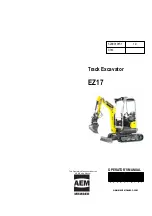
About the Product
Description
6
9831/1450-1
6
Description
General
The JCB Tracked Excavator is a self propelled machine with a tracked undercarriage and a revolving upper
structure which has a boom, dipper, bucket and swing mechanism.
The excavator is mainly used to dig below ground level with bucket motions towards the machine. The upper
structure can slew 360° and discharge material when the tracked undercarriage is stationary.
Intended Use
The machine is intended to be used in normal conditions for the applications and in the environmental conditions
as described in this manual.
When used normally with a bucket fitted to the machine the work cycle consists of, digging, elevating, slewing
and the discharging of material without movement of the undercarriage.
Applications include earthmoving, road construction, building and construction, landscaping and similar
applications.
An excavator can also be used for object handling if it is suitably equipped with relevant parts and systems.
Refer to: Operation > Lifting and Loading (Page 87).
The machine is not intended for use in mining and quarrying applications, in demolition activities, forestry, any
use underground or in any kind of explosive atmosphere.
The must not be used in the following scenarios because of the risk of overturning; used for forestry, used with
attachments of unknown weight, used on surfaces of unknown stability. This list is not exhaustive.
If the machine is to be used in applications where there is a high silica concentration, risk due to materials
containing asbestos or similar hazards, additional protective measures such as the use of PPE (Personal
Protective Equipment) may be required.
The machine should not be operated by any person who does not have an appropriate level of qualification,
training or experience of use of this type of machine.
Prior to use of the machine, its suitability (size, performance, specification etc.) should be considered with
regards to the intended application and any relevant hazards that may exist. Contact your JCB dealer for
support in determining the appropriate JCB machine, attachment and any optional equipment that is suitable
for the application and environment.
Log Moving/Object Handling
Do not use the machine to move or handle logs unless sufficient log protection is installed. You could cause
serious injury to yourself and damage to the machine. For more information, contact your JCB dealer.
Optional Equipment and Attachments
A wide range of optional attachments are available to increase the versatility of your machine. Only the JCB
approved attachments are recommended for use with your machine. Contact your JCB dealer for the full list
of approved attachments available.
Danger Zone
The danger zone is any zone within and/or around the machinery in which a person is subject to a risk to their
health or safety. The danger zone includes the area in immediate proximity to any hazardous moving parts,
areas into which working equipment and attachments can be moved to quickly, the machine normal stopping
distances and also areas into which the machine can quickly turn under normal conditions of use. Depending
on the application at the time, the danger zone could also include the area into which debris, from use of an
attachment or working tool, could be projected and any area into which debris could fall from the machine.
































